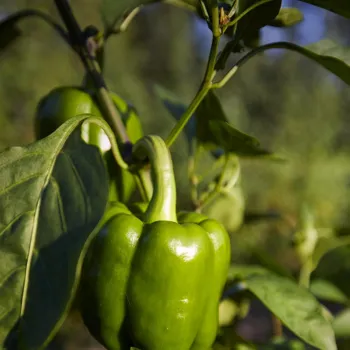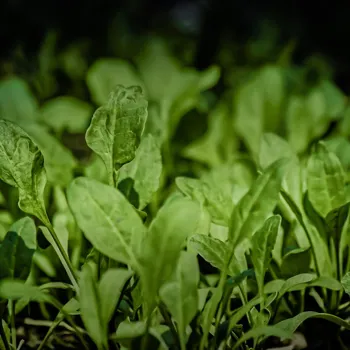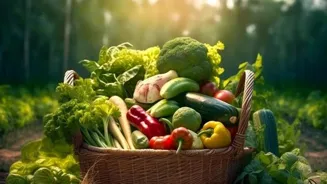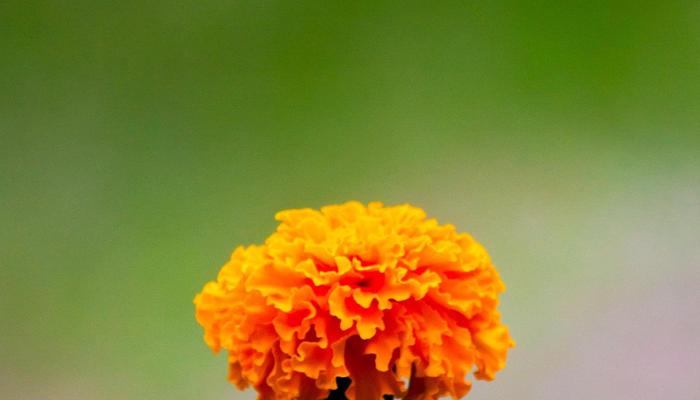Unlock the secrets of growing organic veggies with these 6 expert tips! Dive in for a green thumb journey!
Namaste, readers! Are you tired of paying high prices for vegetables that may or may not be truly
organic? Do you dream of fresh, delicious produce straight from your own backyard?
Well, put on your gardening gloves and get ready to transform your green space because this is your chance to become a true "Gardening Guru"! Growing your own organic vegetables is easier than you think, and incredibly rewarding.
Not only will you have access to the freshest, healthiest food possible, but you'll also enjoy the therapeutic benefits of connecting with nature. Follow these six expert tips and prepare to harvest a bounty of homegrown goodness.
Sunlight is Key: Find Your Vegetable Patch's Sunny Spot
Think of sunlight as the 'chai' for your plants – they absolutely need it to thrive! Most vegetables require at least six hours of direct sunlight per day. So, before you even think about planting, observe your garden space carefully. Note which areas receive the most sunlight throughout the day.

South-facing areas are typically ideal, but even a balcony or a sunny corner of your terrace can work wonders. If your garden is shaded, consider growing leafy greens like spinach and lettuce, which can tolerate partial shade. Remember, happy plants equal delicious veggies!
The amount of sun your vegetable plants receive directly impacts their growth and the quality of the harvest. Insufficient sunlight can lead to weak, leggy plants that produce smaller, less flavorful vegetables.
Before you start preparing your soil or planting seeds, take the time to map out the sun patterns in your garden. Use a compass to identify the direction of sunlight and track how it moves across your space throughout the day. Observe any trees, buildings, or fences that might cast shadows.
This planning is essential for optimal growth.
If your garden doesn't have enough sunshine, consider trying vegetables that tolerate partial shade like herbs like mint, coriander. Also check with your local Agriculture office.
Consider using grow lights especially if you are starting your plants indoors. These lights can replicate natural sunlight and provide the necessary energy for seedlings to grow strong. Place them a few inches above your plants and adjust their height as the plants grow.
Set a timer to ensure they receive the right amount of light each day. This investment can make a huge difference in the success of your garden, especially during the shorter days of winter.
Soil Secrets: Prepare the Perfect Foundation for Growth
Good soil is the "anna" (food) for your plants! It's where they get all their essential nutrients. Don't underestimate the importance of healthy soil. Most garden soil needs some improvement. Start by testing your soil's pH level. You can buy simple testing kits at most nurseries.

Ideally, your soil should have a pH of around 6.0 to 7.0. Next, enrich your soil with organic matter like compost or well-rotted manure. This will improve drainage, aeration, and nutrient content. Healthy soil leads to healthy, happy vegetables!
Understanding your soil type is crucial for successful gardening. Clay soil, for instance, retains water well but can be poorly drained and compacted. Sandy soil, on the other hand, drains quickly but may not hold nutrients effectively.
Loamy soil, a mixture of sand, silt, and clay, is generally considered ideal for gardening. When amending your soil with organic matter, ensure it is fully composted to avoid burning the delicate roots of your plants.
Compost adds nutrients, improves water retention, and promotes beneficial microbial activity in the soil.
Consider using raised beds or containers if your native soil is particularly poor or contaminated. Raised beds provide excellent drainage and allow you to control the soil composition.
Containers are ideal for small spaces like balconies or patios. When filling raised beds or containers, use a high-quality potting mix that is specifically formulated for vegetables. Look for mixes that contain compost, peat moss, and perlite or vermiculite for improved drainage and aeration.
Regularly fertilize your plants with organic fertilizers to replenish nutrients as they grow.
Seed Starting Savvy: Giving Your Veggies a Head Start
Starting seeds indoors is like giving your veggies a VIP ticket to a good start! It's a great way to extend your growing season and get a jump start on planting. You can start seeds indoors a few weeks before the last expected frost.
Use seed-starting trays or small pots filled with seed-starting mix. Keep the soil moist and warm, and provide plenty of light. Once the seedlings are strong enough, gradually acclimate them to outdoor conditions before transplanting them into your garden.
Patience is key, but the rewards are worth it!
Choosing the right seeds is essential for growing healthy and productive vegetables. Opt for organic and non-GMO seeds to ensure the health and purity of your harvest. Consider your local climate and growing conditions when selecting seed varieties.
Some varieties are better suited to hot weather, while others thrive in cooler temperatures. Look for disease-resistant varieties to minimize the risk of plant diseases. Read the seed packets carefully for information on planting depth, spacing, and days to maturity.
Maintain consistent moisture levels in the seed-starting mix to prevent the seeds from drying out. Use a spray bottle to gently mist the soil surface. Avoid overwatering, as this can lead to fungal diseases.
Once the seedlings emerge, provide them with adequate light to prevent them from becoming leggy. Rotate the trays or pots regularly to ensure that all seedlings receive equal amounts of light.
"Hardening off" seedlings before transplanting them involves gradually exposing them to outdoor conditions over a period of one to two weeks. This acclimation process helps them adjust to the sun, wind, and temperature changes and reduces transplant shock.
Watering Wisdom: Know How Much is Enough
Water is life, and your plants are no exception! But overwatering is just as bad as underwatering. The key is to find the right balance. Water deeply but infrequently, allowing the soil to dry out slightly between waterings.
The best time to water is early in the morning, so the foliage has time to dry before nightfall. This helps prevent fungal diseases. Use a watering can or a soaker hose to avoid splashing water on the leaves.
Observe your plants regularly for signs of wilting or stress, and adjust your watering schedule accordingly.
Different vegetables have different watering needs.
Leafy greens, like lettuce and spinach, require consistently moist soil, while tomatoes and peppers prefer to dry out slightly between watering. Consider using a moisture meter to check the moisture levels in the soil before watering. This can help you avoid overwatering or underwatering.
When watering, focus on watering the soil around the base of the plants, rather than the foliage. Wet foliage can create a breeding ground for fungal diseases.
Mulching around your plants can help retain moisture in the soil and reduce the need for frequent watering.
Organic mulches, such as straw, wood chips, or compost, also add nutrients to the soil as they decompose. Water deeply and thoroughly, allowing the water to penetrate deep into the soil. Shallow watering can encourage shallow root growth, making plants more susceptible to drought stress.
Check for signs of overwatering, such as yellowing leaves or root rot. If you suspect overwatering, allow the soil to dry out completely before watering again.
Pest Patrol: Natural Ways to Protect Your Harvest
No one wants uninvited guests munching on their precious veggies! Chemical pesticides can harm beneficial insects and contaminate your produce. Instead, embrace natural pest control methods. Companion planting can be a great way. Marigolds, for example, repel nematodes.
Handpicking pests is also effective for larger insects like caterpillars. Use insecticidal soap or neem oil for more serious infestations. A healthy garden is a resilient garden, so focus on creating a balanced ecosystem.
Encouraging beneficial insects, such as ladybugs, lacewings, and praying mantises, can help control populations of harmful pests. These beneficial insects prey on aphids, mites, and other pests that can damage vegetable plants.
You can attract beneficial insects to your garden by planting flowering plants that provide nectar and pollen. Choose flowers that bloom at different times of the year to provide a continuous source of food for beneficial insects.
Create physical barriers to protect your plants from pests.
Cover young plants with row covers to prevent insects from laying eggs on them. Use netting to protect fruit trees from birds. Practice crop rotation to prevent pests from building up in the soil. Rotate your crops each year, planting different vegetables in the same location.
This can help break the life cycle of pests and diseases. Regularly monitor your plants for signs of pests or diseases and take action promptly to prevent them from spreading.
Harvest Happiness: Enjoy the Fruits (and Veggies) of Your Labor
This is the best part! Harvesting your own organic vegetables is an incredibly satisfying experience. Knowing when to harvest each vegetable is key to maximizing flavor and freshness. Most vegetables are best harvested when they are fully ripe but still firm.
Regularly check your plants for signs of ripeness, such as color changes, size, and texture. Harvest in the morning when the vegetables are at their peak flavor. After harvesting, store your vegetables properly to prolong their shelf life.
Share your bounty with friends and family, and savor the delicious taste of homegrown goodness!
Harvesting vegetables at the right time ensures that they retain their optimal flavor and nutritional value. Overripe vegetables can become mushy or bitter, while underripe vegetables may lack flavor.
Research the specific harvesting guidelines for each vegetable you are growing. Some vegetables, like tomatoes and peppers, can be harvested over a period of several weeks, while others, like carrots and radishes, need to be harvested all at once.
Use clean, sharp tools when harvesting to prevent damage to the plants. Avoid pulling or tearing the vegetables, as this can injure the plant and make it more susceptible to disease. Handle harvested vegetables gently to prevent bruising.
Store vegetables in a cool, dark place to prolong their shelf life. Leafy greens should be stored in the refrigerator, while root vegetables can be stored in a root cellar or a cool, dry basement. Enjoy the fruits (and vegetables) of your labor!
So there you have it!
Follow these six expert tips, and you'll be well on your way to becoming a true "Gardening Guru." Happy gardening!
AI Generated Content. Glance/InMobi shall have no liability for the content









